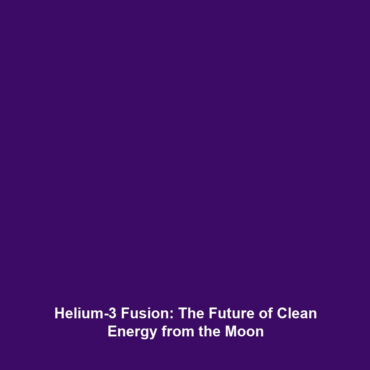Helium-3 Fusion: A Future in Fusion Energy
Helium-3 fusion represents a groundbreaking avenue in the quest for sustainable Fusion Energy. This isotope, found in limited quantities on Earth and more abundantly on the Moon, holds considerable promise for future reactors aiming to provide a cleaner and more efficient power source. As nations and private entities ramp up their exploration and utilization of this vital resource, understanding its significance is pivotal in the broader landscape of fusion research.
Key Concepts of Helium-3 Fusion
Helium-3 fusion involves the reaction of helium-3 nuclei with deuterium or itself to release significant amounts of energy. Here are the central principles related to this innovative fusion reaction:
- Reaction Mechanism: The primary reactions are D + He-3 → He-4 + p (proton), which releases energy without generating neutrons, reducing radiation hazards.
- Energy Yield: Helium-3 fusion produces large amounts of energy, making it attractive for future power generation capabilities.
- Abundance on the Moon: Helium-3 is estimated to exist on the lunar surface in higher concentrations, presenting an opportunity for extraterrestrial mining.
Applications and Real-World Uses
The applications of Helium-3 fusion are diverse and significant when considering the future of Fusion Energy:
- Power Generation: Potential for cleaner energy production with minimal radioactive waste.
- Space Propulsion: Helium-3 can be utilized for advanced propulsion systems, possibly enabling efficient travel across the solar system.
- Medical Uses: The neutrons produced can be harnessed for medical applications, such as cancer treatment through neutron therapy.
Current Challenges of Helium-3 Fusion
Despite the promising prospects of Helium-3 fusion, several challenges remain:
- Cost of Extraction: Currently, mining helium-3 from the Moon is economically unfeasible with existing technology.
- Technical Challenges: Achieving the conditions necessary for helium-3 fusion requires advanced reactor designs and significant engineering breakthroughs.
- Limited Research Funding: Compared to other sources of energy, fusion research often struggles to secure adequate financial support.
Future Research and Innovations
Research into Helium-3 fusion is poised to advance substantially in the coming years. Some areas of innovation include:
- Advanced Reactor Designs: Development of tokamaks and inertial confinement fusion systems tailored for helium-3 fusion.
- Mining Technology: Innovations focused on extracting helium-3 from the Moon more efficiently and economically.
- International Collaboration: Increased partnerships among nations in space exploration and fusion research to maximize resources and knowledge sharing.
Conclusion
Helium-3 fusion stands as a promising pathway within the Fusion Energy sector, potentially addressing the growing energy demands while minimizing environmental impact. By overcoming current challenges and fostering innovative research, Helium-3 could revolutionize energy production in the future. For those interested in following developments in fusion energy, explore more articles on advancements in fusion technology and space exploration resources.
